Alexander of Islay, Earl of Ross facts for kids
Quick facts for kids
Alexander de Yle
(Alasdair MacDomhnaill) |
|
|---|---|
| Earl of Ross and Lord of the Isles | |
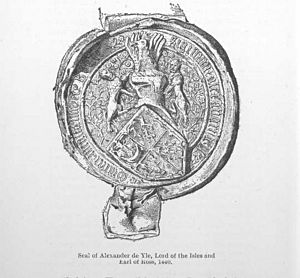
The seal of Alexander. It includes his arms, which contains the arms of the Lordship of the Isles and the Earldom of Ross, surrounded by a royal tressure, indicating Alexander's royal blood as the grandson of King Robert II of Scotland.
|
|
| Reign | 1423/1437-1449 |
| Predecessor | Domhnall of Islay |
| Successor | John of Islay |
| Died | 1449 Dingwall |
| Buried | Fortrose Cathedral, Fortrose |
| Noble family | Clann Domhnaill (Clann Somhairle) |
| Spouse(s) | Elizabeth Seton |
| Issue Among others |
John of Islay Hugh MacDonald, Lord of Sleat Celestine MacDonald, Lord of Lochlash |
| Father | Domhnall of Islay |
| Mother | Mariota MacDonald |
Alexander of Islay (died 1449), also known as Alexander MacDonald, was an important Scottish nobleman in the 1400s. He took over from his father, Domhnall of Islay, as the Lord of the Isles in 1423. Later, he also became the Earl of Ross in 1437.
Alexander's life was full of challenges and changes. He first teamed up with King James I of Scotland against a powerful family called the Albany Stewarts. But once the Stewarts were gone, Alexander and the King quickly became enemies. This led to a war where Alexander's army won a big victory at the Battle of Inverlochy.
Alexander passed away in 1449. By then, he had greatly increased his family's land and power. He was buried at Fortrose Cathedral, which was in his mainland Earldom of Ross, not in the Isles where his ancestors were buried.
Contents
Alexander's Early Life and Royal Connections
Alexander was the great-grandson of King Robert II of Scotland. This meant he had royal blood! He continued his father's plan to support King James I of Scotland. At this time, James had just returned to Scotland after being held captive in England for many years.
When James came back in 1424, another powerful family, the Albany Stewarts, controlled more of Scotland than the King did. By 1425, King James decided to remove the Albany Stewarts from power. Alexander helped him. In May 1425, Alexander was part of a group that decided the fate of Murdoch, Duke of Albany, who was executed.
After the Albany Stewarts were no longer a threat, the main reason for Alexander and the King to work together disappeared. It's thought that King James might have let Alexander control the Earldom of Ross as a reward for his help. Alexander's mother, Mariota Ross, was the rightful heir to Ross, so Alexander became the "Master of the Earldom of Ross."
However, some people believe Alexander taking the title of "Lord of the Isles and of Ross" was a challenge to King James. The King might have also been upset because Alexander's uncle, John Mór MacDonald, was protecting James Mór, who was trying to claim the Scottish throne from King James.
Alexander's Captivity and Escape
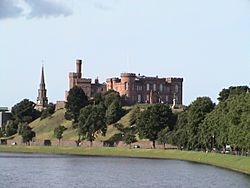
In 1428, King James traveled north to show his power and bring order to the Highlands. He called all the Highland chiefs, including Alexander, to a meeting at Inverness. Alexander and the others went, trusting the King.
However, King James did something unexpected. He arrested Alexander, his mother Mariota, and about fifty of their followers. This included Alexander's uncle, John Mór, who was next in line to be Lord of the Isles. They were all put in the tower of Inverness Castle.
Many important allies of Alexander were also arrested. These included Aonghas Dubh MacKay, a powerful chief, and other leaders from important families in Ross. Most of these men, including John Mór, were released fairly quickly.
King James tried to make a deal with John Mór, perhaps offering him the Lordship of the Isles. But John refused to talk until Alexander was set free. The King's plan went wrong when his messenger, James Campbell, tried to arrest John Mór and accidentally killed him. King James tried to distance himself from the killing and had Campbell hanged. Before the end of 1428, Alexander was released, promising to behave well.
War with the King
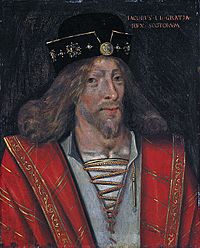
Soon after his release, Alexander was at war with the King again. Donald Balloch Macdonald, Alexander's cousin, might have wanted revenge for his father John Mór's death. He was supported by Alexander's other uncle, Alasdair Carrach. These two powerful nobles likely pushed Alexander into the conflict.
In the spring of 1429, Alexander's army attacked Inverness. Even though the castle's keeper managed to defend it, Alexander still burned down the town. Alexander was also planning to support James Mór, who was still trying to become King of Scotland. James Mór had the support of the King of England, making him a serious threat to King James. Now, Alexander was supporting him too.
However, King James was saved when his rival, James Mór, suddenly died. In the summer, King James gathered a large army and marched north. His army met Alexander's forces near Lochaber. Although Alexander was said to have 10,000 men, some of his allies, like the Chattan and Cameron clans, switched sides to the King. Alexander was defeated in the battle.
Alexander managed to escape, but the King used his victory to take control of Urquhart and Dingwall castles. King James then sent a force with cannons to find Alexander in the Hebrides. Alexander, who had probably fled to Islay, found himself in a difficult spot. On August 27, 1429, he surrendered to King James at Holyrood Abbey near Edinburgh. King James's advisors convinced him to show mercy, and Alexander was sent to Tantallon Castle to be held by the Earl of Angus.
Alexander's Second Captivity and Release
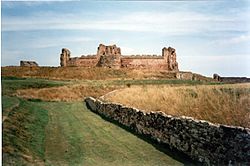
While Alexander was held captive, King James put Alexander Stewart, Earl of Mar, in charge of the northern areas. Mar was given control of the royal earldoms of Buchan and Ross, and Urquhart Castle.
In 1431, there were more battles in the north. At the Battle of Inverlochy, Mar's forces were defeated by Donald Balloch and Alasdair Carrach. Mar managed to escape, but many of his men were killed. Another royal force was defeated in Strathnaver.
These defeats happened before September 1431. King James's first reaction was to raise taxes to pay for another attack, but he had other problems. So, King James decided to make peace with Alexander. Alexander was forgiven for his past actions and released from captivity.
Alexander Becomes Earl of Ross
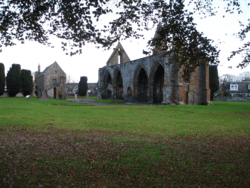
After his release, Alexander remained loyal to the King. He was also lucky. The Earl of Mar, who was in charge of the north, was getting old, and his son had died. When Mar himself died in 1435, King James's plans for the north fell apart.
It was probably around this time, in 1436, that King James finally recognized Alexander as the Earl of Ross. Alexander was now the most powerful nobleman who could bring order to the north-eastern Highlands. He gained control of both Dingwall and Inverness castles.
By January 1437, Alexander was using the title "Earl of Ross" in his official documents, and the King's documents recognized this by 1439. In February 1439, Alexander was given an even more important job: Justiciar of Scotia. This made him the chief legal officer in the Kingdom of Scotland.
With his main goal achieved, Alexander spent the last ten years of his life making his position in Ross stronger. He mostly stayed at Dingwall and Inverness castles. Because he was so busy in the east, he had less direct control over his original lands in the west. His sons, Uisdean (Hugh) and Gilleasbaig (Celestine), were given lands in Sleat and Lochalsh. Other clans, like the Clan MacLeod and Clan MacLean, also gained more independence in their areas.
Family Life
Alexander had children with two partners. He had several sons with the daughter of MacPhee. Later, he married Elizabeth, the daughter of Alexander Seton, Lord Gordon. With Elizabeth, he had:
- John of Islay, Earl of Ross, who became the next Lord of the Isles and Earl of Ross at age fifteen.
Other children included:
- Hugh MacDonald, Lord of Sleat, from whom many current Clan Donald leaders are descended.
- Celestine MacDonald, Lord of Lochlash.
- Margaret Macdonald
- Florence Macdonald
Death
Alexander MacDonald of Islay passed away in Dingwall in May 1449. He was buried at Fortrose Cathedral.
Ancestors
| Ancestors of Alexander of Islay, Earl of Ross | ||||||||||||||||||||||||||||||||||||||||||||||||||||||||||||||||||||||||||||||||||||||||||||||||||||||||||||||||||||||||||||||||||||||||||||||||||||||||||||||||||||||||||||||||||||||||||||||||||||||||||||||||||||||||||||||||||||||||||||||||||||||||||||||||||||||||||||||||||||||||||||||||||||||||||||||||||||||||||||||||||||||||||||||||||||||||||||||||||||||||||||||||||||||||||||||||||||||||||||||||||||||||||||||||||||||||||||||||||||||||||||||||||||||||||||||||||||||||||||||||||||||||||||||||||||||||||||||||||||||||||||||||||||||||||||||||||||||||||||||||||||||||||||||||
|---|---|---|---|---|---|---|---|---|---|---|---|---|---|---|---|---|---|---|---|---|---|---|---|---|---|---|---|---|---|---|---|---|---|---|---|---|---|---|---|---|---|---|---|---|---|---|---|---|---|---|---|---|---|---|---|---|---|---|---|---|---|---|---|---|---|---|---|---|---|---|---|---|---|---|---|---|---|---|---|---|---|---|---|---|---|---|---|---|---|---|---|---|---|---|---|---|---|---|---|---|---|---|---|---|---|---|---|---|---|---|---|---|---|---|---|---|---|---|---|---|---|---|---|---|---|---|---|---|---|---|---|---|---|---|---|---|---|---|---|---|---|---|---|---|---|---|---|---|---|---|---|---|---|---|---|---|---|---|---|---|---|---|---|---|---|---|---|---|---|---|---|---|---|---|---|---|---|---|---|---|---|---|---|---|---|---|---|---|---|---|---|---|---|---|---|---|---|---|---|---|---|---|---|---|---|---|---|---|---|---|---|---|---|---|---|---|---|---|---|---|---|---|---|---|---|---|---|---|---|---|---|---|---|---|---|---|---|---|---|---|---|---|---|---|---|---|---|---|---|---|---|---|---|---|---|---|---|---|---|---|---|---|---|---|---|---|---|---|---|---|---|---|---|---|---|---|---|---|---|---|---|---|---|---|---|---|---|---|---|---|---|---|---|---|---|---|---|---|---|---|---|---|---|---|---|---|---|---|---|---|---|---|---|---|---|---|---|---|---|---|---|---|---|---|---|---|---|---|---|---|---|---|---|---|---|---|---|---|---|---|---|---|---|---|---|---|---|---|---|---|---|---|---|---|---|---|---|---|---|---|---|---|---|---|---|---|---|---|---|---|---|---|---|---|---|---|---|---|---|---|---|---|---|---|---|---|---|---|---|---|---|---|---|---|---|---|---|---|---|---|---|---|---|---|---|---|---|---|---|---|---|---|---|---|---|---|---|---|---|---|---|---|---|---|---|---|---|---|---|---|---|---|---|---|---|---|---|---|---|---|---|---|---|---|---|---|---|---|---|---|---|---|---|---|---|---|---|---|---|---|---|---|---|---|---|---|---|---|---|---|---|---|---|---|---|---|---|---|---|---|---|---|---|---|---|---|---|---|---|---|---|---|---|---|---|---|---|---|---|---|---|---|---|---|---|---|---|---|---|---|---|---|---|---|---|---|---|---|---|---|---|---|---|---|---|---|---|---|---|---|---|---|---|---|---|---|---|---|---|---|---|---|---|---|---|---|---|---|---|---|---|---|---|---|---|---|---|---|---|---|---|---|---|---|---|---|---|---|---|---|---|---|---|---|---|---|
|
||||||||||||||||||||||||||||||||||||||||||||||||||||||||||||||||||||||||||||||||||||||||||||||||||||||||||||||||||||||||||||||||||||||||||||||||||||||||||||||||||||||||||||||||||||||||||||||||||||||||||||||||||||||||||||||||||||||||||||||||||||||||||||||||||||||||||||||||||||||||||||||||||||||||||||||||||||||||||||||||||||||||||||||||||||||||||||||||||||||||||||||||||||||||||||||||||||||||||||||||||||||||||||||||||||||||||||||||||||||||||||||||||||||||||||||||||||||||||||||||||||||||||||||||||||||||||||||||||||||||||||||||||||||||||||||||||||||||||||||||||||||||||||||||

